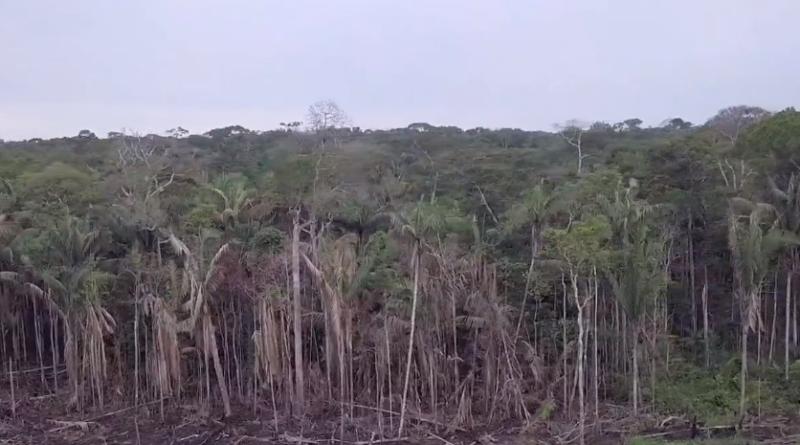‘A biodiversity catastrophe’: how the world could look in 2050 – unless we act now

The climate crisis, invasive species, overexploitation of resources and pollution could break down crucial ecosystems. We asked experts to lay out the risks and offer some solutions
The continued destruction of nature across the planet will result in major shocks to food supplies and safe water, the disappearance of unique species and the loss of landscapes central to human culture and leisure by the middle of this century, experts have warned.
By 2050, if humanity does not follow through on commitments to tackle the five main drivers of nature loss critical natural systems could break down just as the human population is projected to peak.
The Guardian asked leading scientists, Indigenous leaders and conservationists around the world about the consequences of inaction on biodiversity loss by the middle of this century. Despite 1 million plant and animal species at risk of extinction, and in the face of wildfires, floods and extreme weather intensifying due to the climate crisis, nature conservation is increasingly becoming a part of the culture wars raging in many countries, which have spurred opposition to many environmental policies.
Not taking action by the middle of the century may result in extinctions, the rapid spread of invasive species (often bringing new diseases), plastic pollution on a vast scale, crashing fish populations and disappearing forests, experts from every continent have warned.
More than a quarter of all plant and animal species that have had in-depth conservation assessments are at risk of extinction, according to the IUCN red list.
“It fills me with pain to watch the never-ending destruction of natural ecosystems in my home country – Brazil,” said Alexandre Antonelli, director of science at the Royal Botanic Gardens, Kew. “From the Amazonian and Atlantic rainforests to the Cerrado shrublands, trees that are home to myriad insects and orchids, soils teeming with fungi and micro-organisms, and land that jaguars and toucans inhabited for millennia are being brutally lost. The drivers of biodiversity loss are real, and there for anyone to see. Science provides powerful solutions, but time is running out.”
To counteract the potential loss, research indicates humanity must work to restore nature across the planet, adopt more environmentally friendly farming practices, reduce meat consumption, stop the spread of invasive species and dramatically cut the use of fossil fuels.
At the Cop15 biodiversity summit last December, governments agreed on 23 targets, including the restoration of 30% of the planet’s degraded terrestrial, inland water, coastal and marine ecosystems. So far, governments have never met any of their self-imposed targets on nature loss, and experts say that must change urgently.
‘One word: desert’
Sandra Myrna Díaz, an Argentinian biologist who co-chaired the 2019 IPBES assessment of the state of the planet, said: “Over the past 50 years, the most significant driver of biodiversity decline has been, by far, land-use change.
“If these trends continue in the next decades, soil health is likely to deteriorate further due to erosion by intensive annual cropping, [with] pollution by biocides and salinisation. The proportion of nature in direct contact with the wider public will continue shrinking.”
Humanity has cleared about a third of all forests for farming over the past 10,000 years, researchers estimate, destroying key ecosystems such as tropical rainforests, which are among the most biodiverse on the planet.
But experts warn that unique arid landscapes are also at risk. Emma Archer, a professor of geography and environmental science at the University of Pretoria, said: “South Africa’s Karoo landscape is changing, shaped by changing farming systems, increased investments in mining and renewable energy, and by climate change.
“Unless we better understand and address how these different factors are interacting to impact this precious biodiverse landscape – including one of the most biodiverse desert ecosystems in the world – the outcomes will be severe.”
The consequences of land-use change are often interlinked with other drivers of biodiversity loss, warns Cristiane Julião, from the Brazilian Amazon’s Indigenous Pankararu people. “If we do not take the necessary actions to conserve biodiversity, the world’s future and that of our people can be described in one word: desert.
“The Brazilian Amazon, where my people live, would become a desert if the global economic system continues to prioritise exploitation and profit over the health of our planet and people. If we don’t shift the current course of development now, it will be the end of our knowledge, practices and traditions that animals, plants and the climate depend on.”
Invasive species on the march
Last month, an expert UN assessment warned that invasive species had become a multibillion-dollar problem, which is expected to worsen without action on conservation. At least 3,500 harmful invasive species have been recorded globally, spread by human travel and trade, and they are playing an increased role in natural disasters such as August’s deadly wildfires in Hawaii.
Aníbal Pauchard, professor of forest science at the University of Concepción, who helped lead the expert UN assessment, said that without action, by 2050 Chile “will have lost its ecological uniqueness and will be less suitable for nature and people.” About a quarter of Chile’s biodiversity is not found anywhere else on Earth due to natural barriers including the Atacama desert, the Andes and the Pacific Ocean.
Invasive species have become a threat to that, Pauchard said. “Overabundant invasive alien species … will have replaced the unique local ecosystems, causing some native species, especially those endemic to Chile, to go extinct, and others strongly reduced in their numbers.”
Hanno Seebens, from the Senckenberg Biodiversity and Climate Research Centre in Frankfurt, said the warming climate and spread of invasive species could see disease-carrying animals reach new ecosystems in Europe. “Continuing warming due to climate change will allow disease-transmitting species such as the Tiger mosquito … to spread across Europe.”
If nothing changed, Seebens said, the number of invasive species in Europe is expected to double by 2050.
In North America, without increased biosecurity measures, invasive species will threaten human health, native biodiversity and the economy, warned Prof Peter Stoett, who co-chaired the UN assessment on invasive species, which took place over more than four years.
“Invasive grasses will continue to contribute to combustion and forest fires; coastal invasions will further threaten fisheries; climate change is probably going to expand the northward range of zebra mussels and other invaders in the Great Lakes, and there are special concerns about the vulnerability of the Arctic in general,” he said. “This entire ecosystem will change without intensification of control efforts.”
‘Global cooperation is crucial’
Researchers estimate that humans would need 1.7 planet Earths to sustain the current rate of consumption. With more resources required for the green-energy transition, experts say mining firms need to find new extraction methods that minimise damage to nature.
Dr Charles Barber, senior biodiversity adviser at the World Resources Institute (WRI), said: “The boom in mining for the green-energy transition will send miners into the last biodiversity refuges over the next 25 years. Those minerals will get dug up, and we need them. To avoid a biodiversity catastrophe, we need to develop ways to mine far different from the environmentally and socially destructive methods of yesterday and today.”
Unai Pascual, from the Basque Centre for Climate Change, said population growth and urbanisation would put further strain on demand for resources if not managed properly, adding that proper management should ensure there was space for nature in urban areas.
Pascual said: “More than two-thirds of the projected population of 10 billion people will live in cities by 2050. This will increase the energy requirements to manage the growing complexity of urban metabolism. Cities will also increase demand for the extraction of natural resources … with dire risks for the health of ecosystems. A growing share of the population will disconnect from nature, both physically and psychologically.
“If we do not act effectively now to protect and enhance urban biodiversity,” Pascual added, “we will likely see more severe human suffering, especially by the world’s most vulnerable urban inhabitants.”
After decades of overfishing of key species for human consumption, the collapse of fisheries is highlighted as a threat by several experts, especially given the risks from global heating. Dr Jean-Marc Fromentin, from the marine protection body UMR Marbec, said: “Without decisive action, the ocean’s productivity and consequently the world fish catch is set to decline sharply due to seawater warming and acidification caused by climate change.
“This decline will be especially severe in tropical oceans, where wild fish are essential to the food security of local coastal communities,” he said.
Surangel Whipps Jr, president of the Pacific country of Palau and co-chair of the High Level Panel for a Sustainable Ocean Economy, said the world could learn from his country’s customs: “Palau’s bul tradition, a sustainable practice of pausing fishing to replenish stocks, has nourished our generations.
“Global cooperation is crucial,” he said. “Sustainability measures within our exclusive economic zone alone can’t guarantee the world’s ability to provide food, air and water.”
‘Groundwater that can never be cleaned’
The buildup of plastics, chemicals, pesticides and fertilisers in natural ecosystems is highlighted as a threat to biodiversity that demands immediate action, experts say. Dr Marcus Eriksen, co-founder of the 5 Gyres Institute, which works to reduce plastic pollution, said action was vital to avoid flooding key ecosystems with more waste.
“When we published our global estimate of microplastic in the world’s oceans, averaging 170tn particles, we also discovered an alarming and increasing trend. This number would easily quadruple by 2050, likely exceeding the capacity of Earth systems to deal with that level of pollution,” he said.
“This underscores the importance of a strong UN global treaty on plastic pollution, which is being debated now. We cannot recycle our way out of this mess.”
Federico Maggi from the University of Sydney, said: “On the world’s crops and fields, about 3m tonnes of pesticides are used every year to control unwanted plants, fungi and bacteria. Of this amount applied in fields, 82% is biodegraded to simpler molecules currently not fully characterised for their environmental and biodiversity effects. Of the remainder, 10% stays in the soil, while 8% leaches to aquifers.”
The pesticide residues that remain maintain their essential function, he said, “hence reducing biodiversity wherever they are transported … reducing earthworm populations, amphibians, pollinators and many other non-target organisms”.
James Dalton, director of the IUCN global water programme, said the impact of human pollution was also being seen underground, in the world’s groundwater. “We use [water] and often don’t put it back where it came from, meaning we don’t recharge the groundwater with any excess water we took out and didn’t use,” he said.
“The water we use, we pollute, and some of those pollutants go back into the ground. This then slowly infiltrates into our future water supply – sometimes permanently. In the US, they have polluted groundwater that can never be cleaned (think Erin Brockovich).
“The future holds difficult choices,” he said. He called for: “far better regulation of groundwater use; far, far stricter controls on pollutants and monitoring of pollutants; leaving some areas of the planet free from development on the land to protect the water resources underneath.”
‘Huge shift in marine ecosystems’
While climate change poses a direct threat to humanity, it also presents a major threat to swathes of life on Earth, often in unforeseen ways, warn researchers. Henry Häkkinen, a post-doctoral fellow at ZSL’s Institute of Zoology, said: “Seabirds in Europe already face a lot of problems – invasive predators, entanglement with fishing gear, and avian influenza severely threaten their populations, among many other threats. But now our seas are warming up, and this is causing a huge shift in how marine ecosystems function. Many seabirds rely on these cold-water species, especially during the breeding season, and if their food disappears, so too will the seabirds.”
Juan Lucas Restrepo, director general of Alliance of Bioversity International, warned that the climate crisis could present a major challenge to future food supplies in south Asia. “Climate change will continue to be a major driver of changes of [south Asian] ecosystems in the coming decades.
“Rising temperatures, prolonged droughts and extreme climate events are already modifying the natural habitat where many crop species grow … with negative impacts on yields and food security.
“This is a huge threat to environmental, social and economic sustainability in the region. If this trend continues, it will limit food availability and increase food prices, resulting in rising undernourishment.”
Susan Chomba, director of vital landscapes for Africa at the WRI, said navigating the threats posed by the climate crisis in Africa and its ecosystems would have international consequences. “The world can’t solve the hunger crisis, nor the climate crisis, without Africa.
“But today we’re facing a perfect storm: almost 60% of the continent’s arable land is degraded. Over 280 million Africans face hunger. Climate-driven droughts and cyclones are wiping out development gains made in the past decades. Staying on this path will hurt countries’ economies and decimate one of our biggest carbon sinks, the Congo basin.”
Chomba concluded: “Hope lies in the 33 million smallholder farmers who produce over 70% of the food for the continent and export. From Niger to Kenya, these farmers are making major leaps, restoring degraded land into productive farms that grow healthy foods that are rich in biodiversity and are major carbon sinks. Throughout Africa, we’re seeing hope for a new path.”
The following experts also provided their views and helped shape this article: Josef Serttele, Joe Millard, Balkisou Buba, Rukka Sombolinggi, Cristiane Fontes, Charlotte Couch, Erin Matson, Terry Hughes, Stephanie Roe, Zitouni Ould-Dada, Eduardo Brondizio and Chris Carbone





